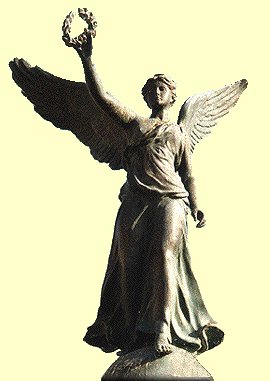Victory

Victoria (from vincere, to conquer) was the Roman personification of victory she was worshipped as a goddess but is more accurately described as a spirit, rather than a goddess. She is usually identified with the Greek goddess Nike but was held in higher regard by the Romans then her counterpart Nike was by the Greeks. Victory was especially worshipped by soldiers and triumphant generals returning from battle. She is usually shown as a winged figure, holding a palm branch or laurel wreath (symbols of victory), descending with flowing robes as a messenger of the gods to bestow the wreath on the victorious. Victory is also depicted decorating or erecting battle trophies and she was symbolized by a so called Victoriola, a small cult statue of Victory standing on a globe and extending a wreath. The Victoriola was handed to a conqueror or victorious person (athlete or general) and symbolized the gift of victory and the renown it conferred.
![]()
Augustus had an altar to Victoria installed in the senate building, the Curia Julia, with a statue of Victoria standing with one foot on a globe. When in 382 AD her statue was removed by the emperor Gratian there was much resistance in the heathen reactionary circles. The cult of Victoria was one of the last pagan cults to succumb to Christianity. The fact that this cult lasted so long is probably due to the fact that she was very popular with the military which made it quite dangerous to ban or forbid her worship outright. By the end of the fourth century, the winged Victory had been transformed into the figure of an angel, the intermediary and attendant of God.